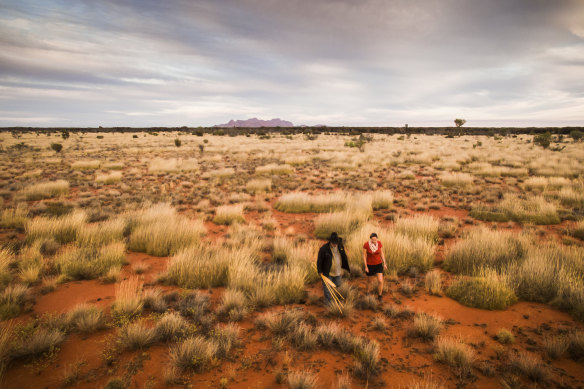This was published 1 year ago
No, it’s not just a big red rock – meet the Uluru family
By Andrew Bain
On the faint road to Patji, Uluru shrinks from a rock to a stone, growing more distant on the horizon. But even as the monolith diminishes, the Uluru name grows ever larger.
This sandy track, once the main road to the famous red rock at Australia’s heart, is now the approach to the homelands of the Uluru family, a deeply personal parcel of land at the southern edge of Uluru-Kata Tjuta National Park.

Exploring Uluru-Kata Tjuta National Park with a guide from SEIT Outback Australia.
The only way out on country here is on a tour with SEIT, guided by a member of the Uluru family. Leading us this day is Daniel Wilson, the great-great-grandson of Paddy Uluru, the family’s early patriarch and traditional custodian of Uluru.
From Uluru, we’ll drive a 100-kilometre loop deep into the desert, passing Patji Rockhole, the fluctuating waterhole that gives this country its name. As we drive, Daniel recounts the unexpected etymology of Patji’s name.
When Paddy Uluru’s sons, Reggie and Cassidy, were once stranded as young boys in Mutitjulu, the Anangu community at the base of Uluru, they found a bike – a patji kala in the Pitjantjatjara language – and decided to make the long ride home. With one dinking the other on the bike through hours of corrugations, they almost reached the rockhole, when the bike snapped in half. Between laughs, they decided the place should take half the name of a bike: Patji.

Uluru fades in the distance.Credit: Andrew Bain
Like many tours, this one stops to pick up food along the way. Shortly after we pass the remains of the old national park welcome arch on what was once the Petermann Highway, Daniel calls for the vehicle to stop and we march off into the sparse bush. Using a shovel and crowbar, he digs at the roots of a witchetty bush, breaking off one root and extracting a plump white grub.
As we turn back for the vehicle, he nods at the witchetty grub. “Bring him with us,” he says. “We’ll cook him up.”
As we continue south, the roads, which are as orange as flames, shrink to almost nothing even as the corrugations grow. Ringneck parrots fly ahead of the vehicle, hurdling between desert oaks, as camels, the great but beautiful pest of the Red Centre, saunter through the spinifex.
Nearing Patji Rockhole, we pull up at a makeshift shelter. Daniels lights a small fire, and the witchetty grub is quickly toasted and eaten amid discussion of its eggy flavour.
“It just needs some spring onions,” Daniel jokes.
Patji Rockhole has been the life-sustaining force for this parcel of desert for millennia. Water levels rise and fall with the seasons, but inspect the sheets of rock encasing the rockhole and its long importance becomes obvious. Now fenced to keep out camels, the rock has been worn smooth in myriad places from generations of women grinding flour from the seeds of the surrounding grasses. From its surface, Daniel lifts a large round stone, found by chance a few years ago, that was one of the grinding stones.
Rising around the rockhole are three boulder-covered hills, looking like African kopjes and, beyond them, another line of rocky hills named Jupiwa. The sun is falling towards the horizon as we pull up at the base of Jupiwa, where we scramble quickly through the rocks to the top of the ridge, looking across flat lands dot-painted in spinifex to Uluru and Kata Tjuta. Not far to the south, across the South Australian border, rise the Musgrave Ranges, topped by the state’s highest mountain.
At the foot of the ridge, behind a rib of rock, the softly spoken Daniel lights another fire and begins to tell us the story of the Uluru family, beginning with the day in 1934 that Paddy and a group of Anangu men were arrested before escaping to a cave at Uluru.
One Anangu man, Yokun, was shot and killed, and Paddy escaped 500 kilometres across the SA border, not returning to Uluru until almost 20 years later, walking back with his wife and children. As he talks, Daniel passes around photos – shots of family members, and Paddy in chains – and a book on the Uluru family emerges.
“I haven’t read it – I heard I wasn’t mentioned in it,” he laughs.
As the fire lights the rocks, stars begin to fill the sky. Far in the distance, Uluru fades from sight, but even in the darkness it remains deep in our minds.
THE DETAILS
Tour
SEIT’s Patji – A True Aboriginal Experience tour departs from Yulara on Tuesdays, Thursdays and Saturdays. The seven-hour tour starts from $349. See seittours.com
The writer travelled courtesy of Voyages Indigenous Tourism Australia.
Sign up for the Traveller Deals newsletter
Get exclusive travel deals delivered straight to your inbox. Sign up now.